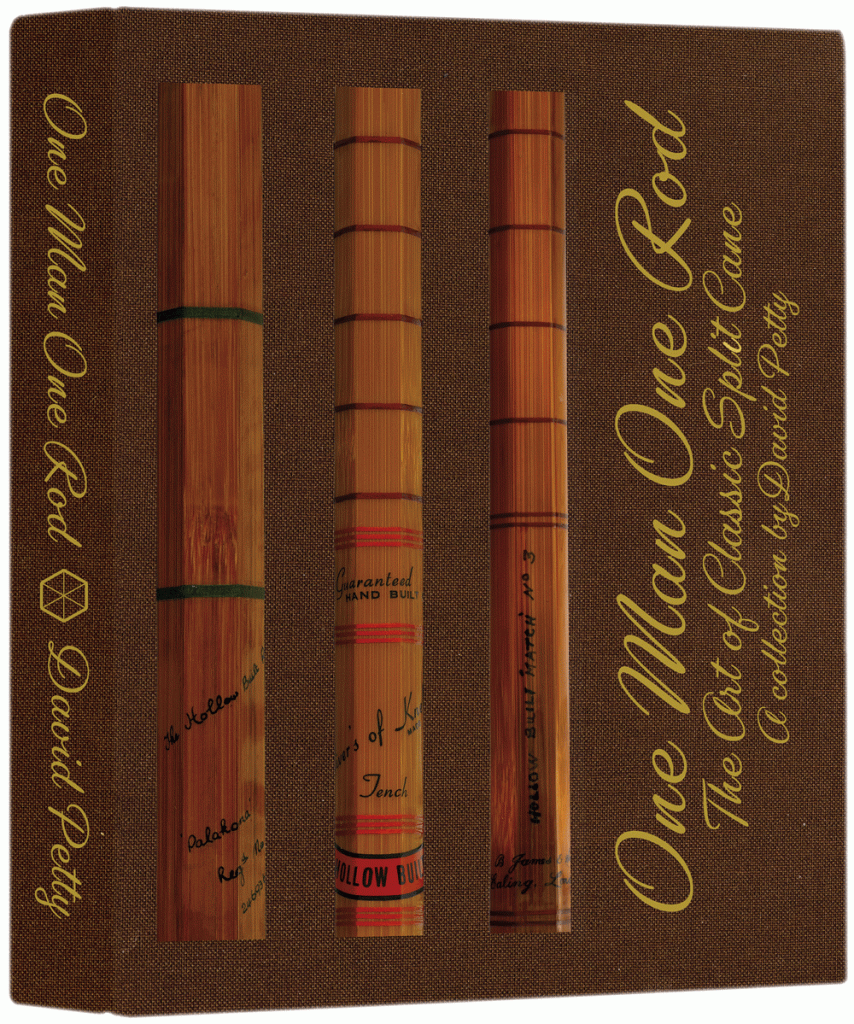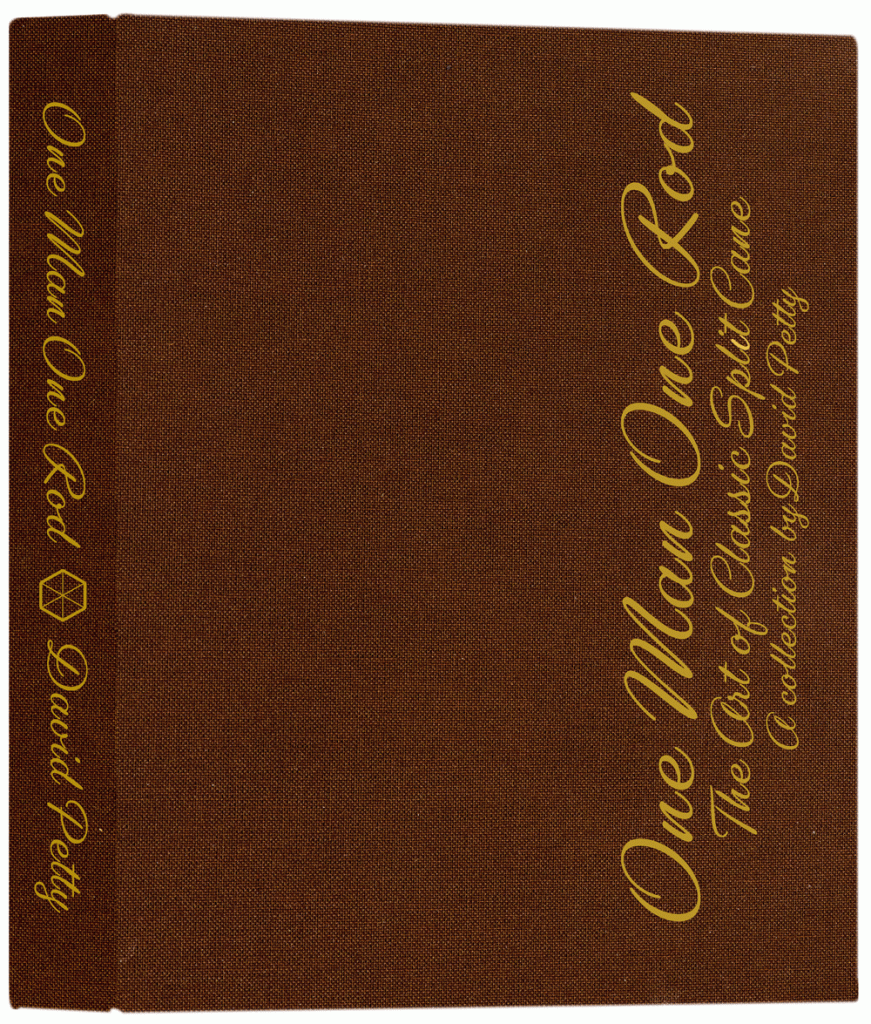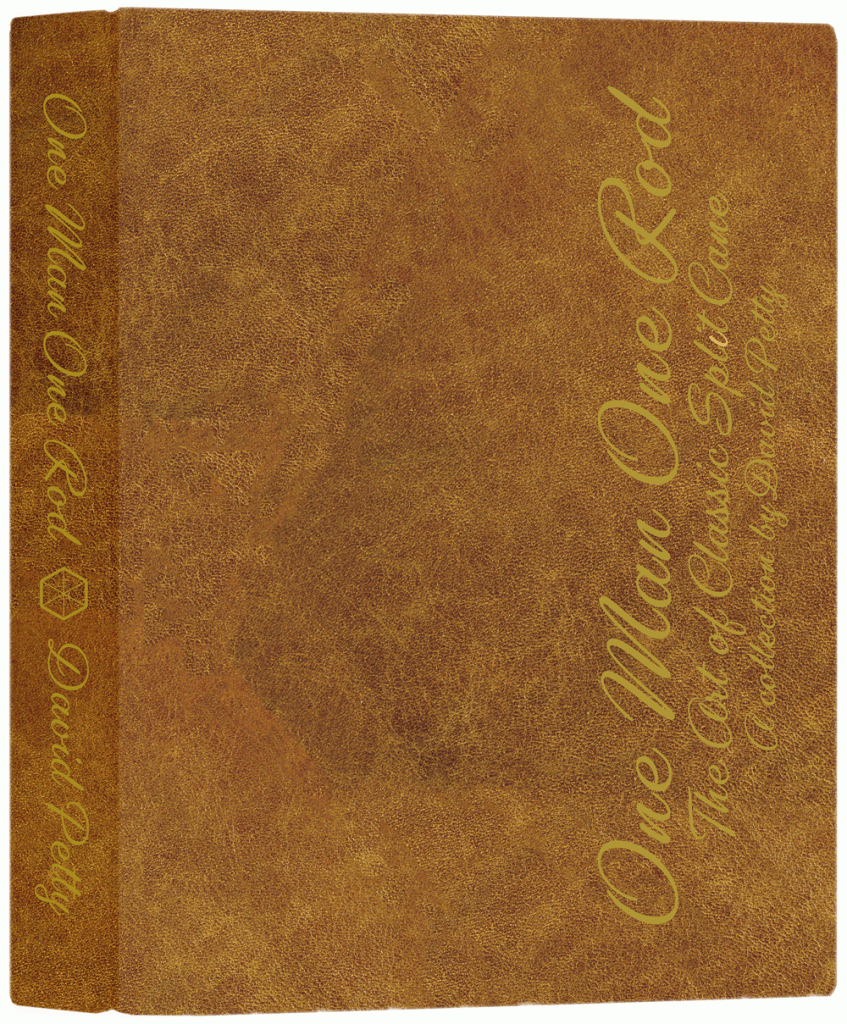The Art of Classic Split Cane – A collection by David Petty – Book Review
I doubt David Petty could have chosen a worse time to publish this book. Corvid-19 has every right-thinking person on the planet running scared. Thousands have already died and it’s not over by a long chalk.
The majority of folk are sat at home wondering if they will have a job to return to when it’s over. Pensions are crumbling and an expensive volume like this might not now be quite as high on the list of necessities that it may have been a fortnight ago and that’s a crying shame because books like this don’t come along very often.
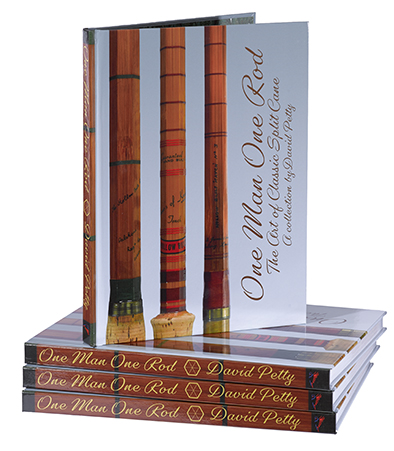
Aimed at the collector and the cane enthusiast you cannot fault the quality of the production and the high art photographs that feature Petty’s fabulous collection of cane rods. This is most probably the finest range of split-cane coarse fishing rods ever assembled and he does them absolute justice.
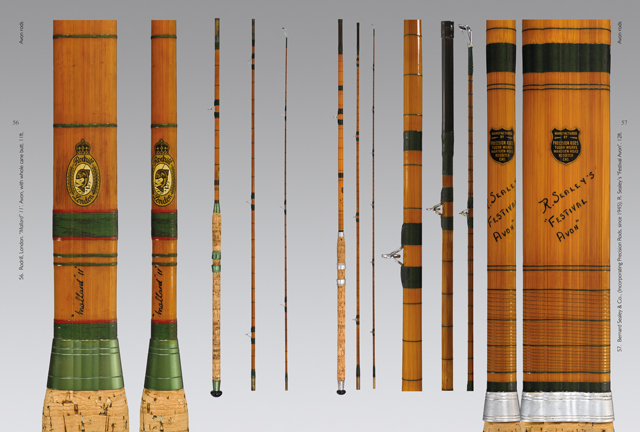
The design and photography is that of Dave Watson who was also responsible John Drewett’s Hardy Brother’s, the Masters, the Men, and their reels. The foreword and common sense guide to buying cane by Edward Barder.
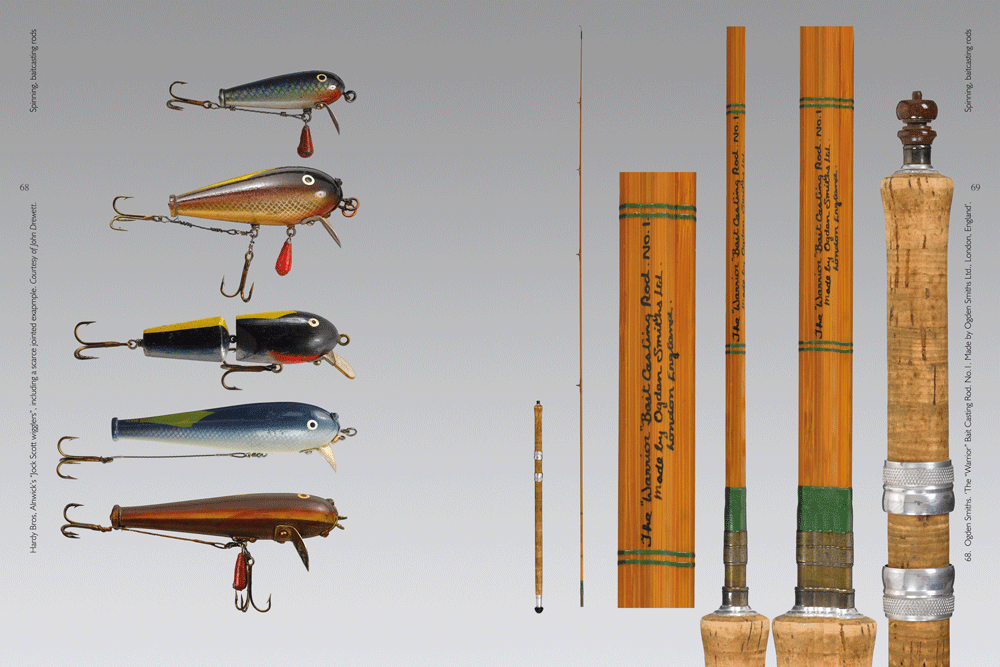
It’s a glossy, weighty production, 300 x 222mm, 208 pages, hard cover, full colour throughout.
The first 200 collector’s copies of the hardback edition carry a bookplate, individually numbered and signed by the author.
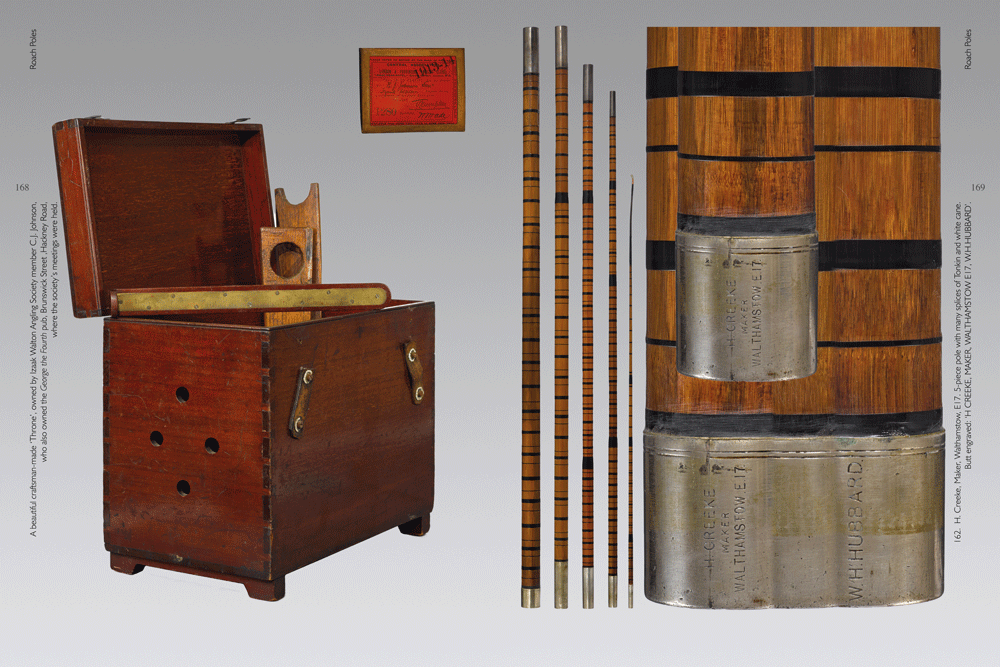
Two de-luxe special editions, leather and cloth bound, each limited to 50 copies will also carry a book plate individually numbered and signed by the author.
The editions:
Hardback £65 + P&P
Cloth limited (50) £185 + P&P
Leather limited (50) £295 + P&P
Tel: +44 (0)1753 644135 Mob: +44 (0)7974 949844
There is also a delightful collection of individually designed bookmarks based on vintage float designs.
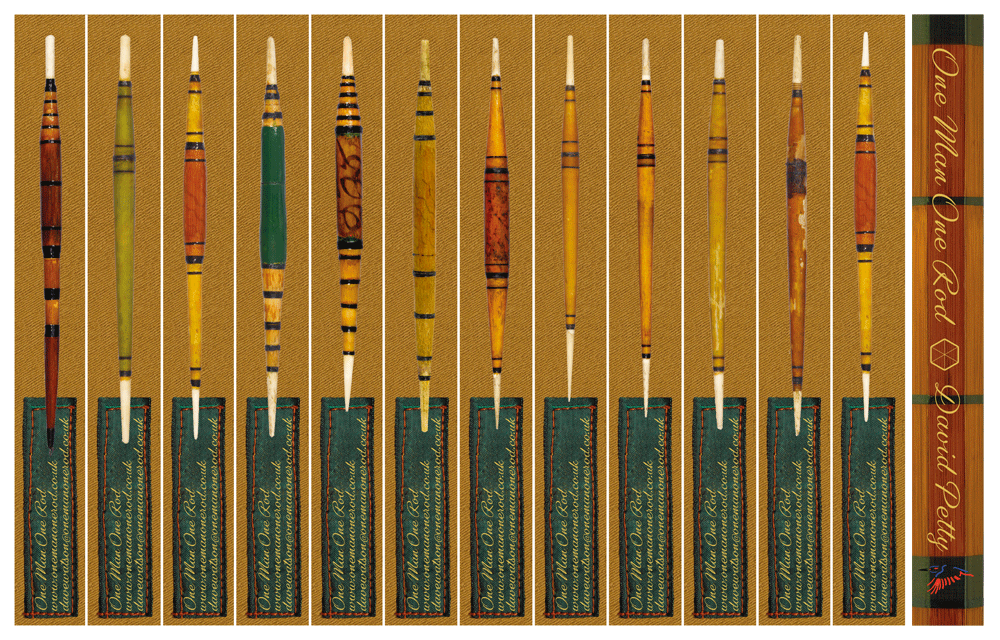
I’m honoured to have been allowed to reprint a couple of extracts from the book, both written by Edward Barder…
Foreword – by Edward Barder
As children my brother and I used to accompany our father on fishing trips. Note that I didnÕt say we went fishing with our dear Dad. We did fish, but spent most of the time climbing trees, running around the shores of the lake and in my brother’s case, roasting sprats over a twig fire that he’d persuaded Dad’s friend Frank Guttfield to build for him. Some of those sprats had been refrozen countless times and weren’t much younger than we were.
My father didn’t so much teach us to fish as introduce us to the idea of fishing. We were shown how to tie a blood knot, how to cast and retrieve a spinner in an effective manner and left to get on with it. We each had a rod and reel from Woolworths. As I grew keener on fishing, marginally less interested in tree climbing and utterly disgusted by my brotherÕs roasted sprats, I took a fancy to one of Dad’s outfits. This was a Hardy split cane spinning rod fitted with a Mitchell reel. Not only did it have obvious style and class, but the rod was far nicer and more tactile than my Hungarian-made solid fibreglass Winfield.
From then on – I suppose I would have been about eight – I was irresistibly drawn to split cane rods. If I saw a friend of Dad’s using one (and many of them still did in the very early 1970s) I always wanted to look at it.
I remember finding two or three very dusty, cobwebby B. James rods leaning up in the corner of my grandparents’ boathouse. Assuming them to be family property I asked if we could fish with them, only for my father to tell me, rather crushingly I thought, that they belonged to the Fort boys, and would therefore be totally clapped out. Knowing what I do about the three fishing Fort boys, now distinguished gentlemen gracefully approaching the last lap of life’s race, I can see that my father’s advice was sound.
Later that year we went to a local tackle shop so that I could choose something better than my Winfield. I went straight to the small selection of second hand split cane spinning rods, sure I would find what I wanted. My father, who is to this day very generous with his advice, told me that I should never buy a second hand split cane rod. He explained that one couldn’t be sure what sort of life it had led, and only an expert could reliably discern whether or not a rod was sound. I left the shop with a superb second hand Abu fibreglass spinning rod but I felt little for it and we were never close.
By the time I was in my mid-teens, I very much wanted to disregard my father’s advice concerning second hand split cane rods and I fantasized about having enough money to buy new ones. En route to fishing, we used to call in at Turners in Reading. It was a rather superior shop run along traditional lines. The proprietor liked split cane rods himself and made sure he carried a stock of whichever models he could obtain from the few firms who could still (in the late 1970s) supply them. I was besotted with the Foster’s ‘Airsprite’ fly rod in the window. The Sharpe’s ‘Scottie’ carp rod in the rack on the right as you went in quietly impressed me and the Gallic sophistication of the Pezon et Michel ‘Fario Club’ was, frankly, outrageous.
These encounters with the objects of my desire continued. I became a fanatic both for angling and fine fishing tackle. School over and earning a wage, I spent generously on my obsession. A B. James & Son MK IV that cost me £30 broke without warning, leading to a ‘Told you so’ from Dad. My attempts to repair the fractured top of the family Milward’s ‘Floatrover’ led to my current occupation. I did eventually save up enough to buy a pair of ‘Scottie’ carp rods and I discovered that there were other people who shared my unusual and sometimes expensive fetish.
Even then there were specialist auctions of vintage tackle. I attended as many as I could and milled about with fellow tackle lovers. We were all intrigued and amused by Chris Partington, I was slightly in awe of Jamie Maxtone Graham, encouraged by Chris Yates and of course, I heard about David Petty. ‘His collection’s the best’, they told me, these other men (and no women I’m afraid) who knew about Walter Dingley, Bob Southwell, Henry Coxon and Jim Vincent Broads Spoons. This was thirty five years ago. I’m still unapologetically crazy about classic cane rods, so are you, Dear Reader and this book is evidence that David Petty is too.
Great collections of beautiful hand-made fishing tackle are rarely seen until they’re broken up and sold off at auction, and no wonder. The guardians of our angling heritage are not museum curators, after all. In this book, David Petty generously gives us access to his fabulous collection of historic split cane rods. As you turn the pages, you’ll nod in recognition at a familiar model by B. James or Allcock, take a closer look at an unknown Sowerbutt, tremble at the sight of the Terrorstrike and covet both of the Oliver’s tench rods.
This book is a visual celebration of the things we love. With his remarkable photography, Dave Watson has not only captured the essence of these rods, he’s presented them in such a clever and original way that I laughed aloud when he showed me the proofs, out of pleasure and surprise.
I want to thank him for doing justice to examples of craftsmanship that invariably, when viewed through any lens but his, look less exquisite than they really are. Dave Watson’s photographic art renders the images of these rods almost tangible and enables us to share with David Petty the pleasure I know they give him.
Guide To Buying Cane – by Edward Barder
In the forword to this book I recalled how my father had told me to steer clear of second hand cane rods. He was both right and wrong. Buying things we are passionate about tends to involve a great deal of emotional excitement and a complete breakdown of the common sense, patience and acuity required to make wise and considered purchases. I speak as someone who has a Cupboard Of Shame. This rarely visited repository (actually a large cardboard tube) contains evidence that I didnÕt know as much as I thought I did as a young man.
Whether you’re a seasoned collector, newly besotted with cane or someone who likes to use bamboo rods for some or all of your angling, I suggest that you try to have a clear idea of what you’re really interested in. Otherwise, you’ll find yourself in a small seaside town, looking forward to a spot of lunch and an afternoon swim, when your wife, husband, care worker or parole officer suggests popping into an antiques arcade for a few minutes.
Reluctantly you’ll enter, immediately registering the smell unique to these places, of boiled cabbage, ancient unwashed soft furnishings, pee-pee and beeswax. As your companion browses among the EPNS cutlery, sub-Lalique glass and incomplete Clarice Cliff tea sets, you’ll spot an umbrella stand from which protrudes an assortment of fishing rod sections. Of course, you recognise them for what they are. A moment later you’ve pulled out a two piece split cane boat rod made by a firm youÕve never heard of. It’s only thirty quid and it seems a shame to leave it there. It might be fun to catch a pollock or a wrasse with, from those rocks you saw earlier. You’re probably thinking about giving it a coat of varnish when you get it home and before you know it, you’ve paid cash and it’s yours.
You complete nit-wit! It’s your life to live as you see fit, but if you carry on like this, you too will have a cupboard full of useless, clapped out old rods. Bear with me and I’ll show you how to choose well, to avoid endless bouts of buyer’s remorse and to have, at worst, only a small cardboard tube filled with kindling.
Please allow me to help you.
Successfully buying rods without first inspecting them is perfectly possible, but you should only do so from reputable dealers who will provide detailed and accurate descriptions of their stock. You shouldn’t hesitate to ask them about a rod if you feel like it and they should be happy for you to do so.
If you’re tempted by a rod on ebay or other online sales platform (is that what they’re called?), obtain a completely satisfactory description and pictures of the rod, ask questions about it and ensure that you can return it if it’s not what you expected. Quite a few reputable dealers operate ebay shops, so don’t dismiss them out of hand, but do be cautious and level headed.
Wherever you shop, don’t rush. If something looks a bit out of whack in some indefinable way, it’s probably a dud. Trust your instincts and buy the most self-evidently well made rods your budget will allow. You can tell an Aston Martin from a Trabant, a Rolex from a Timex. By using your common sense and sober observation you should be able to see the qualities that make an Oliver’s Roach Perfection superior to my old Hungarian Winfield.
Try to visit dealers whose stock is of genuine interest (but don’t kick their tyres too much) and view as many auctions as possible. Specialist tackle sales and vintage tackle shows are great fun. They provide the best opportunity to examine a lot of rods, to meet dealers and enjoy the company of other anglers with impeccable tastes.
The internet, of course, will overwhelm you with a blizzard of information, a great deal of which is not going to help you much. Try to deploy your brain’s inbuilt filtration system. There are some very good forums and website for lovers of classic fishing tackle. Enjoy these in moderation.
If you dig about, there are a surprising number of books that deal with classic rods and tackle. You’re reading this one, the best of them all of course, but others are worth investigating. Classic Angling magazine is also very well worth its modest annual subscription. Spend within the prudently established limits of your fishing tackle fund. Profligacy may well lead to an enviable collection of Kennet Perfections, but nobody to have dinner with.
We’ve had a bit of a chat and established that you’re primarily interested in three piece Avon-style rods, especially the ones with whole cane butt sections. You’d prefer to stick to the high quality stuff and you want to fish with the rods you buy. Join the club!
You’ve spent several evenings sifting through the Angling Auctions catalogue for this Saturday’s sale. The lots you’re interested in are circled in red biro and you’ve inserted a list in the front of the catalogue to remind you of lot numbers, estimates etc. Or, if you’re frightfully smart, perhaps you’ve done something clever with your iPhone.
We’re at the viewing nice and early. After a bit of rummaging you’ve found lot 38, an Allcocks Super Wizard. Before even thinking about assembling it, clean your specs.
First of all, we’ll look very carefully and systematically at each section, flat by flat.
Do the joints look tight? Gaps anywhere in the hexagonal section’s corners are evidence either of less than perfect manufacturing or glue failure. The odd visible glue line (as these gaps are known), while not ideal, is forgivable if the section passes the other tests you’ll be subjecting it to. If the gaps are frequent and the varnish over the joints is flaky or missing, exposure to damp is the likely cause. You’ll see dark, almost black water marks on the cane too, nine times out of ten.
Bamboo is composed of fibres contained within a starchy water soluble resin. If a rod’s blank is exposed to damp, the strength and vigour of bamboo will be compromised. A good sound varnish finish is therefore essential. The Super Wizard weÕre looking at has plenty of varnish on it. You can see its thickness and the obvious runs and blobs, indicating that a previous owner has taken the wise precaution of over-varnishing the original finish, inexpertly but effectively protecting the cane from the elements. Good! The corners of both tip and middle are tight, solid, as they should be. Allcock’s rods were very accurately and soundly made in this respect.
Now look at the rings. Do any of them appear to have been replaced or re-whipped? Are the centres free from rust? If they’re lined, check for cracks and chips. The frames should not be obviously bent or rusty either. This is a Super Wizard, which means that unlike the ordinary Wizard, all of the rings are lined. Look at those linings. They’re an opaque orangey-brown colour. This tells you that they’re made from Agate, which is hard stuff that won’t groove easily.
On close inspection, you get the impression that the butt ring is of a different pattern to the tip and intermediate rings. Well spotted. Its centre looks like glass of some sort, with a tortoiseshell effect, and the whippings are a slightly darker shade of red than its neighbours. It’s a later replacement but it’s perfectly serviceable and doesn’t spoil the look of the rod too much.
The other whippings are all of a piece and none of them are split or frayed. They do look a bit blotchy though. This is due to the varnish over-coat noted a few minutes ago. Most cane rods had their whippings ‘doped’ to flatten the silk’s fibres and seal them so that subsequent coats of varnish wouldnÕt penetrate and darken the thread. The varnishes of the time, based on natural resins such as copal and linseed, tended to oxidise, shrink and dry out. Without exception, they became very porous after a few years, hence the need for over-varnishing. The newer varnish has gone through the old stuff all right but it’s sealed in the goodness so all is well.
Rods in completely original condition are rare and can be wonderful, but if you intend to fish them much, you’ve got to keep an eye on the weather and make absolutely sure that they’re always wiped down after use and stored somewhere dry. Their original finishes may look fine, but trust me on this; they’ll leak like a sieve if it rains.
We’ll have a very close look at the ferrules now. The male ferrule on the tip section is a bit tarnished but you can see that it’s larger in diameter than the split cane it’s fitted too. This is extremely important. It shows that the tip wasn’t turned down and weakened in order to fit it to the ferrule. If you see a ferrule on a rod tip that looks mean and undersized, beware.
On assembling such a rod you’ll often notice that it’ll not sight straight through the tip ferrule area. The whippings at the ferrule will probably be badly cracked too, another sure sign that the split cane has been turned down excessively and weakened. It’s taken a set (a fixed bend) as a result and it will probably snap off or fracture sooner or later if it’s fished with.
Anyway, so far so good with the Super Wizard. Look at the end of the male ferrule. It terminates with a brass disc so it’s waterproof. Cheap rods lack this feature so water can get into their cane. When wet split cane swells inside a ferrule, it’s very likely to crack it.
The female ferrule at the top of the mid-section still has its nice little cork and ebonite stopper. This is a really nice feature. It shows that the previous owner cared for the rod and made sure he didn’t lose these important little articles (the female on the butt section has its stopper too). They prevent a build-up of lint and grit from forming in the ferrule.
Someone once asked me why he couldn’t insert a male ferrule more than half way into the female. I poked about in the female with a cocktail stick (anything metallic would risk scoring the inside of the ferrule) and removed half an inch of compacted lint. The ferrules had lost their stoppers years ago. Let’s move over here so that we can look really closely at the ferrules in the natural light coming in now that the sun’s out.
The brass tube has a dark silvery-bronze chemical finish. This is always applied to ferrules on quality rods. Bare metal looks too flashy. It’s just showing a little wear here and there where the cellulose lacquer it was coated with has worn off. This is pretty normal and critically, no cracks, hairline or otherwise are visible in the tubing. Unless a rod is extremely rare and in otherwise outstanding condition, I would suggest that you steer clear of rods with cracked ferrules. They’re buggers to replace properly and the only acceptable excuse is that brass is an unpredictable alloy which does occasionally crack without provocation.
The male ferrule at the other end of the mid-section is also sound. As well as cracks, look out for dents, deep scoring or obvious abrasion of the tube. Verdigris should sound alarm bells too. It usually forms on brass when it’s been wet for too long and as we’ve discussed, damp storage and fishing rods are a bad combination.
I can see from the way you keep shifting your weight from one foot to the other that you’re either desperate to use the loo or you can’t wait to put the rod together, but hold on. We’ve got to go over the whole cane butt section. It’s an aesthetic conundrum, but these classic rods with sections made from seemingly unmatched materials look just right.
No two pieces of whole cane are exactly alike, but Allcocks held a huge stock of canes and they knew which ones to use. Most of these butts work in harmony with their split cane middles and tips. The tubular bamboo seems to flex in a way that it gives a very effective springiness in the butt. Hopefully this one won’t be a dud.
The female ferrule on the butt is in good condition. The whole cane is free from cracks, as it should be. A cracked whole cane section is very likely to collapse under strain. Cracks can be repaired sometimes, but their presence indicates either a fault in the bamboo or damage to it by force at some time. Have a sight down the section from the handle to the ferrule stopper. Turn it slowly as you sight down it. You can see subtle bulges where those two long whippings are.
The long whippings cover the knots that occur at intervals in bamboo and the butt is about as straight as one can reasonably expect. What you don’t want to see is a butt that curves like a banana. This is usually a sign that the bamboo has been over-strained to the point where its fibres can’t return to their former position. Sometimes this can be rectified by careful heat straightening, but it’s a ‘don’t try this at home’ task so be very wary of bent butts.
The Allcocks Wizard’s whole cane butt was let into an eighteen inch length of beech dowel. This balanced the rod nicely and gave the handle a reassuringly solid feel. You’ll notice that the handle looks as though it’s made from one piece of cork. It’s a little dark and shiny from use, but you can still see the seam along its length. It’s actually made from sheet cork that was wrapped over the glue-covered beech dowel base. This was very clever and skilled work. One day, if you need help getting to sleep, I’ll tell you how it was done.
For now, the main thing is that there are no patches of cork missing and the some of the bronzing on the brass sliding reel bands is intact. If a Super Wizard of this vintage (late 1940s I’d say, judging by the agate lined rings, gold oval transfer and brass handle fittings) has been really heavily used, the reel bands will have lost all of their finish and you may well be able to see the beech dowel in places where the sheet cork has worn through.
The black rubber button is in place and if you look carefully you’ll see that there’s a green felt washer between it and the brass butt cap. This is a nice original feature and it prevents the button from fusing to the butt cap.
Finally, well almost, we can put the rod together and see if we think it would be good to fish with.
Hold the tip section next to the ferrule with the rings facing upwards. Hold the middle next to its female ferrule and as you look down on the sections, try to align the rings. Gently and steadily insert the male half way into the female. I predict that it won’t require much force. The rod has had enough honest use to put some wear into the male ferrule. Let’s hope not too much.
Now, sight down the two sections. If the rings are slightly out of alignment, check again that none of them are bent or poorly fitted to the rod. If they look OK, hold the ferrules and gently twist them to align the sections correctly. Sight down the joined sections again. This time they look properly lined up so grip them firmly adjacent to the ferrules again and push the male ferrule in at least three quarters of the way.
If you encounter resistance at this stage, STOP PUSHING – or this will happen:
Thirty years ago I was viewing lots at Bonhams. On the first table I came to was the most delectable Avocet by B. James & Son. It had the maker’s name engraved on one side of the butt cap and Bernard Venables engraved opposite. It had two matching tips and was whipped in the loveliest apple green silk. It was the best looking rod I’d ever seen. Rather hurriedly, I shoved the middle into the butt and then attached one of the tips.
I gave the rod the obligatory waggle and felt the heft of it. I was completely overcome with rod-lust. There were a lot of other things to see so I started to dismantle the rod. The tip ferrule popped out nicely but the middle, which I’d assembled rather energetically, parted far too easily from the butt. With buttock-clenching horror, I realised that the ferrules were still firmly together. The whole cane butt section had pulled out of its female ferrule.
To say that I reddened with embarrassment would be to understate things. I managed to get enough grip on the female ferrule to pull it free from its male counterpart. Amazingly, nobody seemed to have seen my dreadful act of vandalism so I shoved the female back in placed and walked rapidly into another room.
The rod sold for £200 to a man I later came to know. He never mentioned the loose ferrule on Bernard’s old Avocet, but I still felt bad about it. I few years ago the rod changed hands again. The man who’d bought it came to our workshop and asked if we could fix the ferrule. It wasn’t just loose, it was cracked. This was too much. I had to confess my sins. We managed to replace the ferrule and refinish it so cunningly that the work was undetectable. There was no charge. It had taken twenty eight years, but I’d atoned for my sin.
Back to the Super Wizard. No, don’t show off your new rod assembling skills just yet. Hold the middle section in both hands and gently waggle it. Careful, don’t wave it about like that or you’ll knock over Mr Freeman’s cup of tea. Now, when you’re waggling it, can you feel any knocking or ‘ticking’ emanating from the ferrule area? Really concentrate and listen as well as feel.
If you can detect a knock or tick, push the ferrule right in if it’ll let you without force. If the knocking stops, you’ve got a rod with a sound if slightly worn ferrule. If you hold the rod with the ferrule in one hand and there’s a ticking that seems to be coming from somewhere else, the split cane may well be de-laminating. I’d put the rod down and look at something else.
Ferrules may be loose because the metal-to-metal contact is poor due to wear, or the tubing has become un-glued from the rod blank, or both. Glue failure is extremely common and easily remedied by refitting, either by a competent amateur or professional rod repairer. Very worn, loose ferrules can be tightened by various means, or they can be replaced. They do suggest though that the rod has had a lot of use and may be worn in other ways too. If this is the case, put a question mark by the rod’s entry in the catalogue and move on.
The Super Wizard’s ferrules are quite an easy fit but they don’t knock and there’s about a sixteenth of an inch of male ferrule still showing when the joints are firmly inserted. Now for the moment of truth.
Take a look down the rod. Be careful. The sale room has filled up now and you could have someone’s eye out with that thing. It looks pretty good from where I’m standing. It droops a bit but don’t worry about that yet. Now turn it though ninety degrees and look again. With the rings facing left, it still droops but there’s a very slight curve to the left too, in the top half of the rod. The droop is just the rod bending under its own weight. The slight set tells us that the rod’s bamboo fibres have yielded over the years to the load placed on them during fishing. This shouldn’t be anything to worry about. Bamboo is a natural material and it’s not inert. Think of it as akin to the barely perceptible subsidence to the back of your house, over the cellar and only visible from the orangery.
Here’s Mr Freeman. He looks a bit preoccupied but he’s a kindly old chap so let’s ask him if we can put a very gentle, very careful bend in the rod. He graciously says yes, keeping an eye on us. He hasn’t forgotten that Bonham’s sale either. He was the auctioneer! I’ll hold the tip ring firmly while you apply a little pressure. Don’t push the rod towards me you twit! Just lift it slightly. It describes a very nice progressive curve doesn’t it? The tip bends easily and sensitively. It blends into the middle without any obvious dog-leg so there aren’t any nasty bamboo-stressing hinge points in the action. The whole cane butt has reserves of power but isn’t unpleasantly rigid. Quickly relax the rod and I’ll let go of the tip ring. Now look down it.
If the rod has returned to the position it was in before we put a bend in it, it’s sound and the cane hasn’t become ‘soft’ from over-strain. If a rod stays very bent after you’ve put a reasonable bend in it, you should avoid it. This one is good and you like the way it feels. You’re already thinking about the tench fishing you’d like to use it for this summer and the chubbing in the winter, but don’t get ahead of yourself old chum. You might not make the highest bid this afternoon.
Now that youÕ’ve looked intelligently at the other lots on your list, you’ve decided to go all out for the Super Wizard. The estimate is £200 – £250. It’s up to you, but my strong advice is to set yourself a limit that won’t get you into trouble at home but will give you a fair chance. You’re not stupid, or at least I hope not as you’re the chief executive of a large merchant bank, but don’t get carried away. If you really want this rod it would be perfectly sensible to go to £300 for it.
Three hours later, you’ve bought a very nice rod for £285. All you need now is an afternoon off, a clear river and a loaf of bread.
